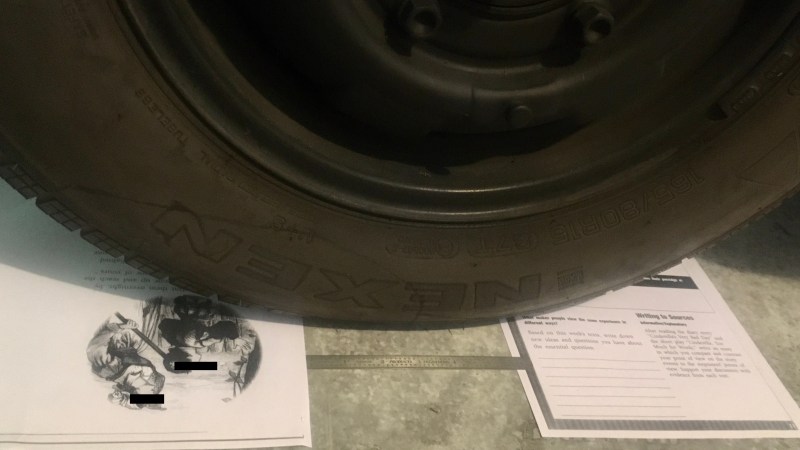Sometimes a problem is more important than its solution. Humans love to solve mysteries and answer questions, but the most rewarding issues are the ones we find ourselves. Take [Surjan Singh], who wanted to see if he could calculate the weight of his Saab 96. Funny enough, he doesn’t have an automobile scale in his garage, so he had to concoct a workaround method. His solution is to multiply the pressure in his tires with their contact patch. Read on before you decide this is an imperfect idea.
He measures his tires with a quality gauge for the highest accuracy and pressurizes them equally. Our favorite part is how he measures the contact patch by sliding a couple of paper pieces from the sides until they stop and then measures the distance between them. He quickly realizes that the treads didn’t contact the floor evenly, so he measures them to get a better idea of the true contact area. Once he is satisfied, he performs his algebra and records the results, then drives to some public scales and has to pay for a weigh. His calculations are close, but he admits this could be an imprecise method due to an n-of-one, and that he didn’t account for the stiffness of the tire walls.
This was a fun thought experiment with real-world verification. If you’re one of those people who treats brainstorming like an Olympic sport, then you may enjoy the gedankenexperiment that is fractals.
















If only I could buy a SAAB96 for only $4k
I have owned more Saab 95/96 then I can remember, most of them were used for different motorsports and “consumed” but I also had a fair share of road registered ones.
Now I only have a couple of bins of parts left, sadly not the intake for double standing Webers I used in my racecar, or any of the crossed intakes for dual webers.
I had a dream to rebuild a roadlegal car with a race engine, but then I drove one, and belive me, the nostalgia is best cultivated in the memory….
Came across something like this for the first time. It would surely have been a fun experiment.
The US Army taught me that method 40 years ago.
It’s a common seondary school physics question. It’s also in one of the Brian Cox books. Fairly ubitquitous actually.
So if he averaged the calculated weight accounting for treads and the weight not accounting treads he would have been almost spot on.
And here I was thinking the documentation outweighed the car.
In what reality does the official Saab service documentation DVD weigh more than a car? I want a world where cars weigh a few ounces and DVDs weigh 3500 pounds.
Did we really need to block out the faces of the illustration on the paper? Someone might identify the kids in the 19th century wood cutting and steal their identity??
It was completely unnecessary, but I giggle when I see it.
I saw the experiment on Beakman’s World decades ago
I ordered the Beakman’a World book of experiments off a cereal box years ago with this in it.
Congratulations!
Helped a friend do this 50 years ago for a high school physics class, but we also measured tire height to the center of the hub because obviously, 50 years ago tire pressure gauges were so incredibly accurate.
I took a load of recycling to the transfer station and they weighed my car for free.
That’s a hack, if I’ve ever heard one!
Sometimes you have to think outside the trash barrel.
Doing otherwise will make you Grouchy.
While I applaud the effort, I have a (weird) car that I somewhat often drive, feel it’s a little wriggly in back, and find it has zero tire pressure and all that’s holding it up is the sidewalls, so I suspect they bear a significant proportion of the total weight on lightweight cars.
Mr Wizard did this in the (early?) 80s. Back when there were only a couple of kids science shows on TV.
Couldn’t he have just put a piece of carbon paper under each tire and added up the surface area? Or am I missing something?
Maybe I’m looking at things differently, but wouldn’t you have to drive the car onto the carbon paper? If you did that, how will you determine what to add when the vehicle is parked? Even if you used a jack and slid it under each tire, the jack would have shifted the weight distribution of the remaining 3 tires.
Hey, I’m doing a similar project like this right now and I was wondering if anyone good at physics could help me out as I am not doing too hot.